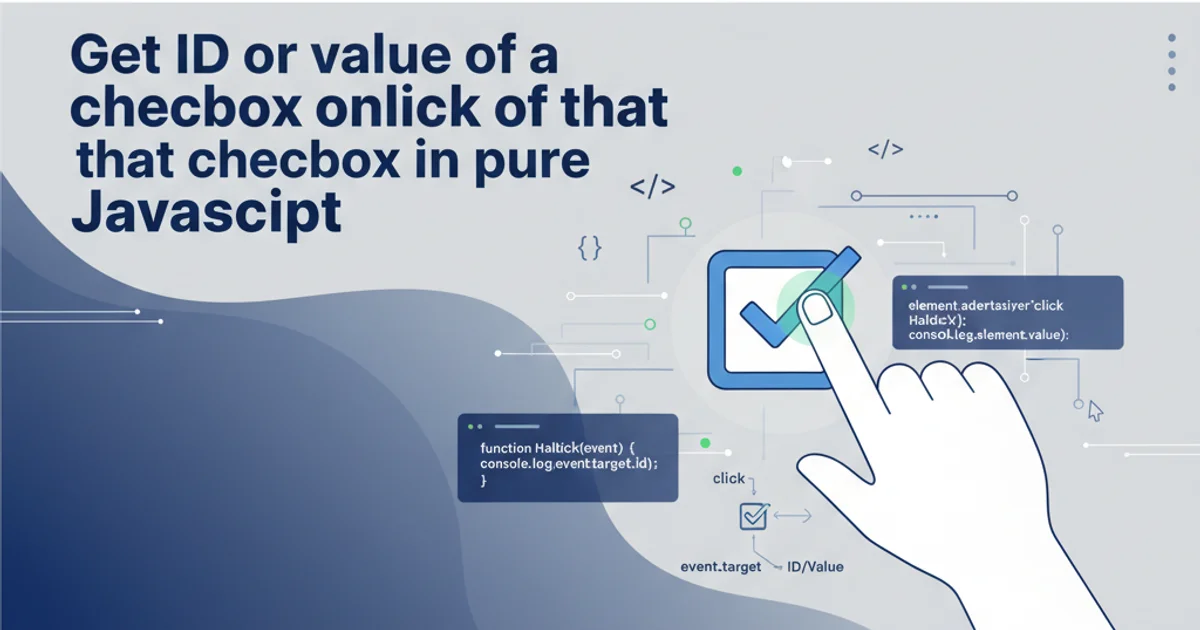Get ID or value of a checkbox onclick of that checkbox in pure Javascript
Categories:
Retrieve Checkbox ID or Value On Click in Pure JavaScript

Learn how to efficiently get the ID or value of a checkbox immediately when it's clicked using vanilla JavaScript, without relying on external libraries.
Interacting with form elements is a fundamental part of web development. Checkboxes, in particular, often require immediate feedback or data processing when their state changes. This article will guide you through the process of capturing the ID or the current value of a checkbox directly when a user clicks it, using only pure JavaScript. This approach ensures minimal overhead and direct control over your DOM manipulations.
Understanding Checkbox Events
When a user interacts with a checkbox, several events can be triggered. The most relevant for our purpose are click and change. While change is generally preferred for form elements as it fires when the element's value is committed (e.g., after a text input loses focus or a checkbox is toggled), click is perfectly suitable for checkboxes if you need immediate action upon the physical click. For checkboxes, both events typically fire at roughly the same time when the user clicks on them, making click a straightforward choice for instant feedback.
flowchart TD
A[User Clicks Checkbox] --> B{Event Listener Attached?}
B -->|Yes| C[Event Object Created]
C --> D{Target Element Identified}
D --> E[Retrieve `id` or `value` from Target]
E --> F[Perform Action (e.g., log, update UI)]
B -->|No| G[No Action Taken]Flowchart of checkbox click event handling
Implementing the Event Listener
To capture the ID or value, we need to attach an event listener to the checkbox. This listener will execute a function every time the checkbox is clicked. Inside this function, the event object provides access to the element that triggered the event (the event.target). From event.target, we can easily extract properties like id or value.
<input type="checkbox" id="myCheckbox1" value="optionA">
<label for="myCheckbox1">Option A</label>
<input type="checkbox" id="myCheckbox2" value="optionB">
<label for="myCheckbox2">Option B</label>
Basic HTML structure for checkboxes
document.addEventListener('DOMContentLoaded', function() {
// Get all checkboxes on the page
const checkboxes = document.querySelectorAll('input[type="checkbox"]');
// Loop through each checkbox and attach an event listener
checkboxes.forEach(function(checkbox) {
checkbox.addEventListener('click', function(event) {
// The 'this' keyword inside the event listener refers to the checkbox itself
// Alternatively, use event.target
const clickedCheckbox = event.target;
const checkboxId = clickedCheckbox.id;
const checkboxValue = clickedCheckbox.value;
const isChecked = clickedCheckbox.checked;
console.log(`Checkbox ID: ${checkboxId}`);
console.log(`Checkbox Value: ${checkboxValue}`);
console.log(`Is Checked: ${isChecked}`);
// You can now use these values for further logic
if (isChecked) {
console.log(`Checkbox '${checkboxId}' with value '${checkboxValue}' is now checked.`);
} else {
console.log(`Checkbox '${checkboxId}' with value '${checkboxValue}' is now unchecked.`);
}
});
});
});
JavaScript code to get checkbox ID and value on click
document.querySelectorAll('input[type="checkbox"]') is a robust way to select all checkboxes. If you have a specific container for your checkboxes, you can narrow down the selection, e.g., document.querySelector('#myContainer').querySelectorAll('input[type="checkbox"]') for better performance on large pages.Handling Dynamically Added Checkboxes
If your checkboxes are added to the DOM dynamically after the initial page load, the querySelectorAll approach might not catch them. In such cases, event delegation is a more effective strategy. Instead of attaching listeners to individual checkboxes, you attach a single listener to a parent element that is always present in the DOM. When an event bubbles up to this parent, you check if the event originated from a checkbox.
document.addEventListener('DOMContentLoaded', function() {
const parentContainer = document.getElementById('checkboxContainer'); // A parent element that exists on page load
if (parentContainer) {
parentContainer.addEventListener('click', function(event) {
// Check if the clicked element is a checkbox
if (event.target.matches('input[type="checkbox"]')) {
const clickedCheckbox = event.target;
const checkboxId = clickedCheckbox.id;
const checkboxValue = clickedCheckbox.value;
const isChecked = clickedCheckbox.checked;
console.log(`(Delegated) Checkbox ID: ${checkboxId}`);
console.log(`(Delegated) Checkbox Value: ${checkboxValue}`);
console.log(`(Delegated) Is Checked: ${isChecked}`);
}
});
}
// Example of adding a checkbox dynamically
setTimeout(() => {
const newCheckbox = document.createElement('input');
newCheckbox.type = 'checkbox';
newCheckbox.id = 'dynamicCheckbox';
newCheckbox.value = 'dynamicOption';
const newLabel = document.createElement('label');
newLabel.htmlFor = 'dynamicCheckbox';
newLabel.textContent = 'Dynamic Option';
parentContainer.appendChild(newCheckbox);
parentContainer.appendChild(newLabel);
console.log('Dynamically added a checkbox.');
}, 2000);
});
Event delegation for dynamically added checkboxes